Dessert Tea
Dessert tea offers a delightful alternative to traditional sweets. It's crafted to give you the sensation of indulging in desserts without the calories. Often, these teas are flavored with ingredients like fruits, spices, and chocolate.
There are various types of dessert teas available. Some popular flavors include vanilla, caramel, chocolate, and cinnamon. These teas can be enjoyed hot or iced, making them versatile for different seasons.
| Flavor | Notes |
|---|---|
| Vanilla | Smooth, creamy, and sweet |
| Caramel | Rich, buttery, and decadent |
| Chocolate | Deep, cocoa-rich flavor |
| Cinnamon | Warm, spicy, and comforting |
Dessert teas can be enjoyed at any time of day. They are perfect for a mid-afternoon treat or a post-dinner beverage. You can pair them with light snacks or enjoy them on their own.
Bestsellers
Some benefits of dessert teas include their lower calorie content compared to actual desserts. They can also offer a relaxing, sensory experience with their aromatic profiles.
You can find these teas in many forms, such as loose leaf, tea bags, and even ready-to-drink bottles. Consider trying different brands and blends to find your favorite.
Popular Types of Dessert Tea
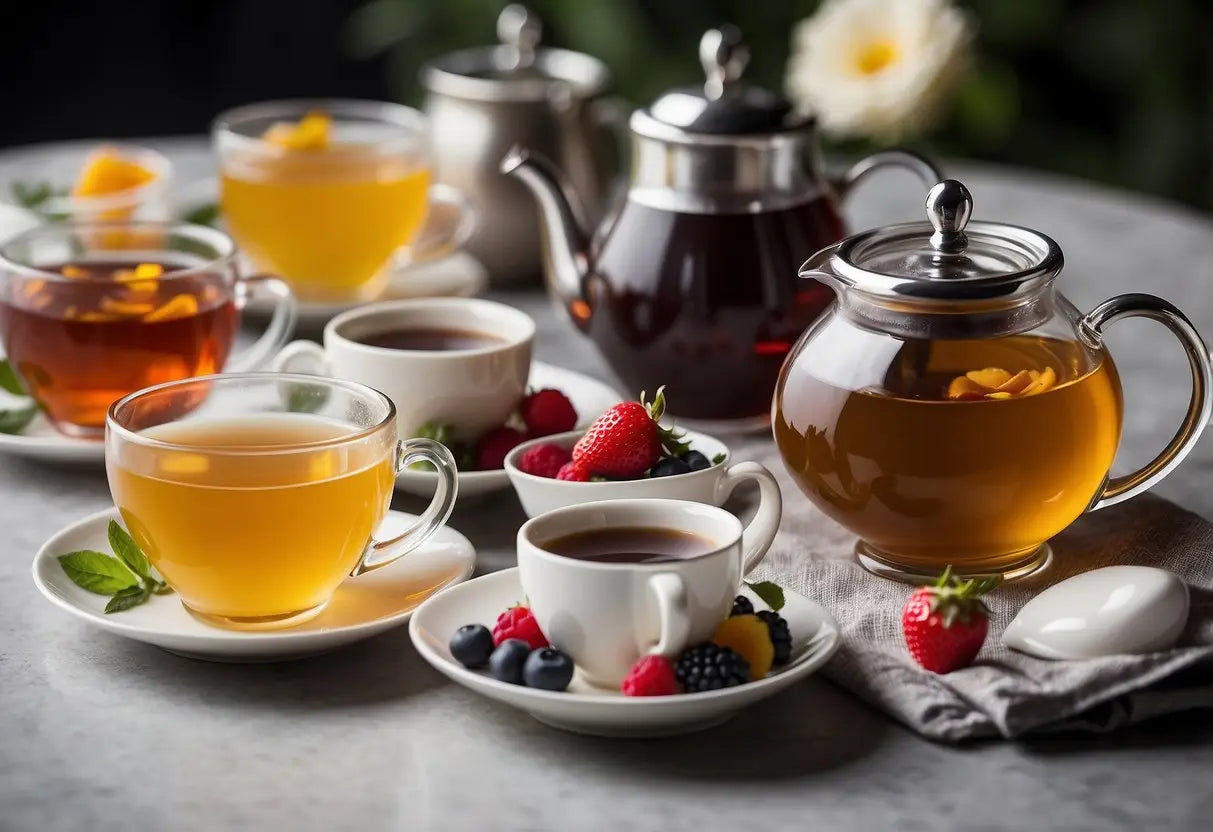
Dessert teas offer a unique and flavorful experience, presenting a range of sweet and indulgent tastes. You’ll find a variety of blends, each created to satisfy different cravings without the added calories of traditional desserts.
Black Tea Blends
Black tea blends are rich and bold, often paired with dessert flavors such as vanilla, caramel, and chocolate. These teas are perfect when you want a robust flavor profile. Earl Grey Crème is a popular choice with its addition of vanilla and cream notes.
Other notable blends include Chocolate Chai and Caramel Black Tea. The tannins in black tea provide a full-bodied taste, making it a satisfying choice for those who enjoy a more intense tea experience derived from dessert-inspired flavors.
Herbal Infusions
Herbal infusions are caffeine-free and can range from fruity to spicy. Popular options include Chamomile and Lavender Lemonade, both known for their calming properties and sweet, floral flavors. Peppermint Chocolate is another delightful choice, combining refreshing mint with the richness of chocolate.
Fruity combinations like Apple Cinnamon and Peach Cobbler are also favored for their ability to replicate dessert flavors in a soothing, warm drink. These infusions are perfect for late-night cravings as they won't interfere with your sleep.
Green Tea Varieties
Green tea varieties usually incorporate lighter, more delicate flavors, ideal for those who prefer a subtle sweetness. Matcha Latte blends are popular for their creamy texture and rich umami taste. Another favorite is Jasmine Pearls, which combine green tea with the sweet aroma of jasmine flowers.
Mint Green Tea and Lemon Meringue Green Tea offer refreshing and zesty flavors. These teas are less processed than black tea, retaining more antioxidants. They're a healthier choice for satisfying your sweet tooth.
Rooibos-Based Teas
Rooibos-based teas are naturally sweet and caffeine-free, making them an excellent choice for dessert teas. Vanilla Rooibos has a smooth, creamy flavor that mimics classic desserts. Cinnamon Rooibos Chai combines spicy and sweet notes, perfect for a warming treat.
Red Velvet Rooibos and Berry Cheesecake Rooibos are other popular blends, offering rich, indulgent flavors without any bitterness. Rooibos tea is also rich in antioxidants, making it both a delicious and beneficial choice for your health.
Lao Ban Zhang
Health Benefits of Dessert Tea
Dessert tea not only satisfies your sweet cravings but also offers notable health benefits. It provides antioxidant properties, a calorie-free way to enjoy sweetness, and aids your digestion.
Antioxidant Properties
Dessert tea is rich in antioxidants that help combat oxidative stress in your body. These antioxidants, such as flavonoids and catechins, neutralize free radicals. This can potentially reduce the risk of chronic diseases.
Key antioxidants in dessert tea include:
- Catechins
- Flavonoids
- Polyphenols
These compounds contribute to improved heart health and may help in cancer prevention. Regular consumption can also promote overall cellular health, keeping you feeling energized and healthy.
Calorie-Free Sweetness
Unlike traditional desserts, dessert tea offers a way to enjoy sweetness without the added calories. This makes it an excellent choice if you're watching your weight. Traditional sugary treats can lead to spikes in blood sugar and added calories.
Benefits include:
- Zero calories
- No added sugars
- Suitable for diabetics
Opting for dessert teas can satisfy your sweet tooth while helping prevent weight gain. This makes it easier for you to stick to a balanced diet.
Digestive Aid
Certain ingredients in dessert teas, such as peppermint, ginger, and chamomile, aid in digestion. These ingredients can help soothe your stomach, relieve indigestion, and reduce bloating.
Digestive benefits:
- Eases indigestion
- Reduces bloating
- Soothes the stomach
Enjoying a cup of dessert tea after meals can be a gentle, natural way to promote digestive health. You can feel comfortable and less bloated.
Brewing Techniques for Dessert Tea

Brewing dessert tea involves distinct preparation methods to elevate its sweet and aromatic flavors. Key techniques include loose leaf preparation, tea bag steeping, and cold brew methods.
Loose Leaf Preparation
Loose leaf preparation offers control over the flavor profile and strength of your dessert tea. Start with fresh, high-quality leaves. Use one teaspoon per cup, but adjust accordingly for a stronger brew.
Heat your water to the optimal temperature, usually between 175°F and 195°F for dessert teas. Steep the leaves for 3-5 minutes to extract the desired sweetness and aroma. Use a fine-mesh strainer or infuser to remove the leaves before serving. Tip: Experiment with additional spices like cinnamon or vanilla to enhance flavors.
Tea Bag Steeping
Tea bag steeping provides convenience without compromising on flavor. Choose high-quality dessert tea bags. Begin by boiling water and letting it cool slightly to around 185°F.
Steep the tea bag for 2-3 minutes. Over-steeping can cause bitterness. For a richer taste, consider using two tea bags per cup. Some dessert tea bags come pre-flavored, reducing the need for sweeteners or additional ingredients. Remember to squeeze the bag lightly before removing it to extract every drop of flavor.
Cold Brew Methods
Cold brew is ideal for a refreshing version of dessert tea, especially in warmer weather. Use loose leaf or tea bags. In a large pitcher, add one tablespoon of loose leaf tea or three tea bags per liter of cold water.
Refrigerate for 6-12 hours. The extended steeping process removes bitterness and enhances the natural sweetness. Strain the tea or remove the bags before serving. Serve over ice with optional add-ins like mint leaves or a splash of fruit juice.
Pairing Dessert Tea with Food
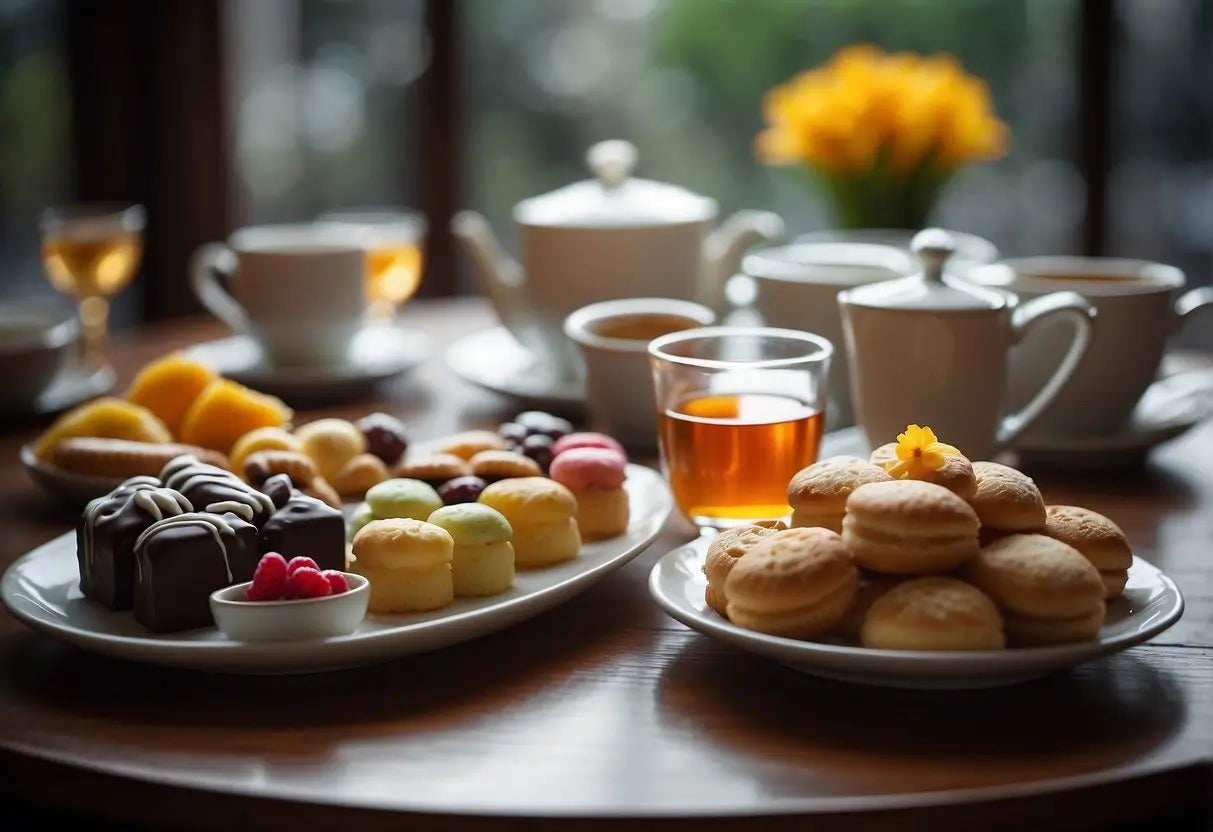
Pairing dessert tea with food enhances both the drink and the dish. The key is to match or complement flavors to avoid overwhelming one with the other.
For fruity teas like peach or berry, consider light desserts such as fruit tarts, sorbets, or citrus-flavored snacks. These combinations bring out the natural sweetness and fruitiness in each other.
Creamy teas such as vanilla or caramel pair excellently with rich desserts like custards, crème brûlée, and anything chocolate. The smoothness of the tea enhances the creaminess of the dessert.
When you're enjoying spiced teas like chai or cinnamon, try pairing them with baked goods or pastries such as spiced cakes, gingerbread cookies, or cinnamon rolls. The spices in both the tea and the food create a harmonious balance.
Teas with nutty flavors or accents, like almond or hazelnut tea, work well with nutty desserts like pecan pie, almond biscotti, and baklava.
Sample Pairings
| Tea Flavor | Food Pairing |
|---|---|
| Fruity (Peach) | Fruit Tart, Sorbet |
| Creamy (Vanilla) | Crème Brûlée, Chocolate Cake |
| Spiced (Chai) | Gingerbread, Cinnamon Roll |
| Nutty (Almond) | Pecan Pie, Almond Biscotti |
Experiment with these pairings to find what suits your taste. Enjoy the delightful harmony of dessert teas and complementary foods.
Cultural Significance of Dessert Tea
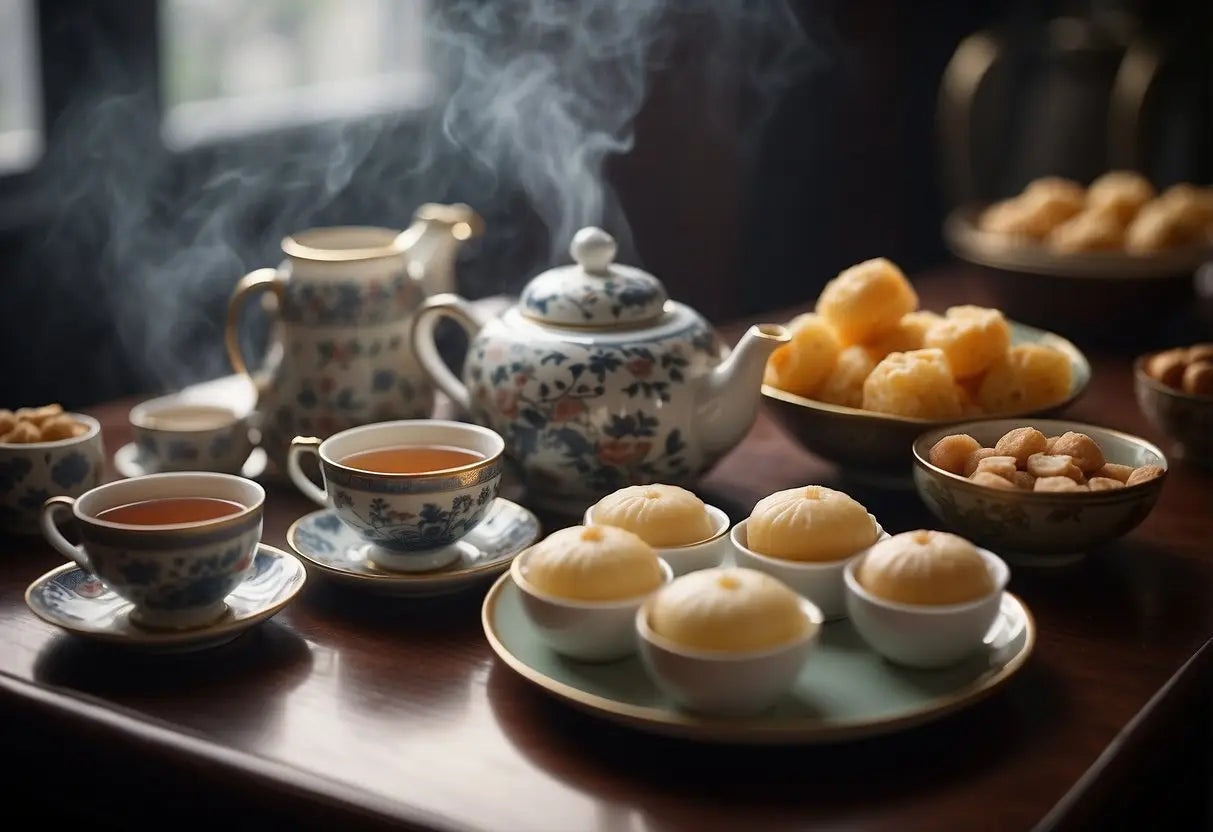
Dessert tea holds a special place in various cultures. It is often associated with traditions and customs that emphasize relaxation and community.
British Tea Time
British tea time, particularly the afternoon tea tradition, incorporates dessert teas as a key element. Served with sweets such as scones, éclairs, and cakes, dessert teas complement the flavors and textures of these treats.
The practice started in the early 1840s and continues to be a social event. The ceremony is marked by its formal setting and specific etiquette, including the use of fine china and a selection of different teas. The inclusion of dessert teas adds a sweet touch to the experience.
Afternoon tea remains a cherished part of British culture, celebrated for both social interaction and its rich history. The focus is on enjoyment and the pleasure of companionship.
East Asian Tea Customs
In East Asian cultures, dessert teas are commonly linked with special occasions and rituals. Japan's tea ceremonies, for instance, often feature sweet teas that are paired with traditional confectioneries like mochi and wagashi.
Chinese traditions also include dessert teas such as jasmine or oolong, served during festive events. These teas are valued not only for their flavor but are also believed to aid digestion following a meal.
In Korea, sweet teas like the honey citron tea are popular, particularly in the colder months. Such teas are appreciated for their soothing qualities and health benefits. The customs emphasize harmony and respect, underscored by the careful preparation and presentation of the tea.
Each culture brings its own unique touch to the concept of dessert tea, enriching the tradition with distinctive flavors and practices.
Dessert Tea Recipes and Innovations

Chocolate Peppermint Tea
Combine peppermint tea with a dash of cocoa powder. Add a touch of honey or agave to sweeten. Serve hot or chilled for a refreshing treat.
Vanilla Almond Delight
Steep vanilla rooibos tea and add almond milk. Sweeten with a bit of maple syrup. This tea works well both hot and iced.
Caramel Apple Spice Tea
Brew spiced apple tea. Add a small amount of caramel syrup and a sprinkle of cinnamon. Ideal for warming up on a chilly evening.
Matcha Latte with a Twist
Mix matcha powder with warm milk. Sweeten with a hint of vanilla extract and a teaspoon of agave. Perfect for a creamy and unique dessert experience.
Steep Earl Grey tea with a few sprigs of lavender. Add honey to enhance the floral notes and balance the robust flavors of the tea.
| Tea Type | Ingredients | Serving Suggestion |
|---|---|---|
| Chocolate Peppermint | Peppermint tea, cocoa powder, honey | Hot or chilled |
| Vanilla Almond Delight | Vanilla rooibos, almond milk, maple syrup | Hot or iced |
| Caramel Apple Spice | Spiced apple tea, caramel syrup, cinnamon | Hot |
| Matcha Latte Twist | Matcha powder, warm milk, vanilla extract, agave | Hot |
| Lavender Earl Grey | Earl Grey tea, lavender, honey | Hot |
Experimenting with these recipes allows you to enjoy dessert in a cup. Adjust sweetness and flavors to your taste.
Serving and Presentation Tips
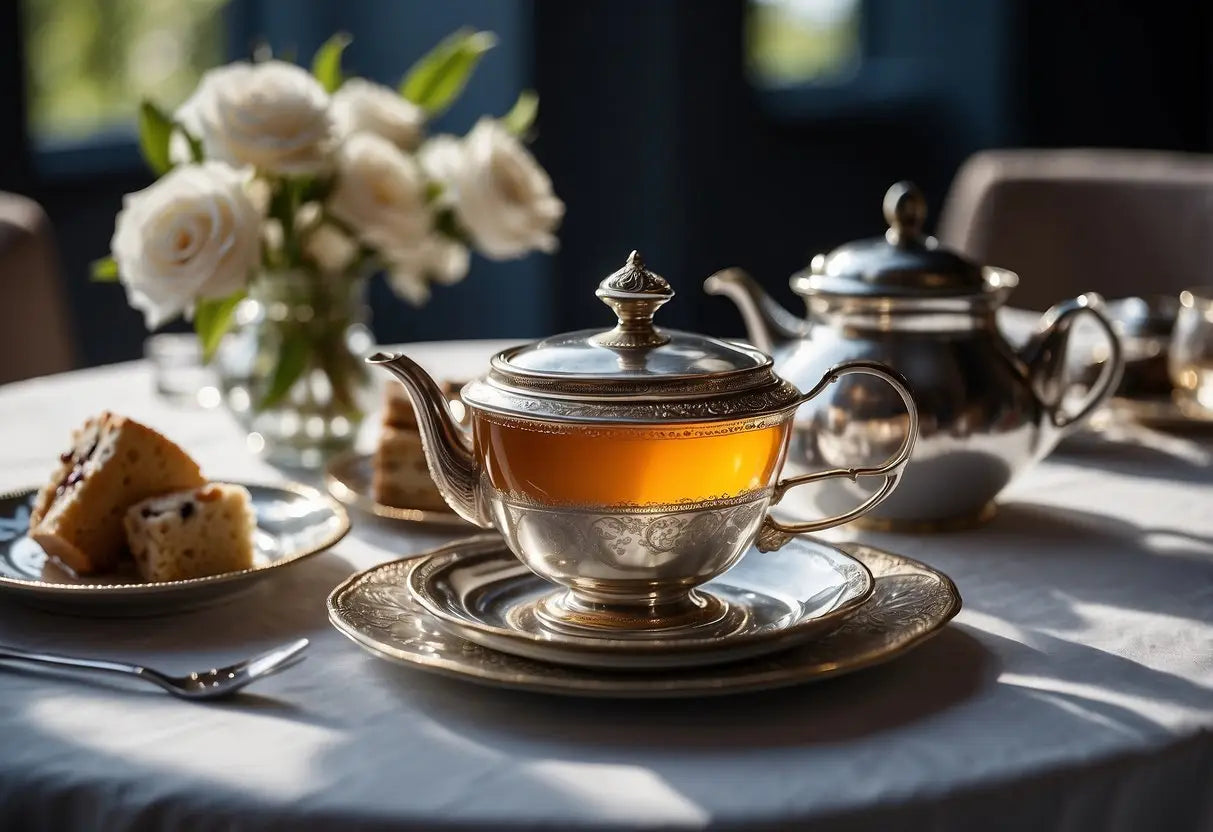
When serving dessert tea, the presentation can elevate the experience. Use fine china or clear glass teapots to showcase the tea's color.
Temperature: Serve the tea at the right temperature. Too hot or too cold can ruin the flavor.
Garnishes: Consider garnishing with fresh fruit slices, mint leaves, or edible flowers for added appeal.
Table Setting
| Item | Description |
|---|---|
| Teacups | Small, elegant cups enhance the tasting experience. |
| Saucers | Matching saucers keep it tidy and stylish. |
| Teapot | Use a matching teapot to complete the set. |
Use linen napkins and place a small spoon on the saucer. This adds a touch of elegance.
Layered Desserts: Pair your tea with layered desserts like parfaits, which complement the tea's flavor.
Sweeteners: Offer diverse sweeteners such as honey, sugar cubes, or stevia.
Pay attention to the details. A small plate of delicate biscuits or chocolates can accompany the tea perfectly.
Presentation
- Pouring Technique: Pour slowly and steadily for an even flavor distribution.
- Serving Tray: Use a polished serving tray to carry the teapot and cups to your guests.
By focusing on these aspects, you can create a delightful and memorable tea-serving experience.
Selecting Quality Dessert Tea
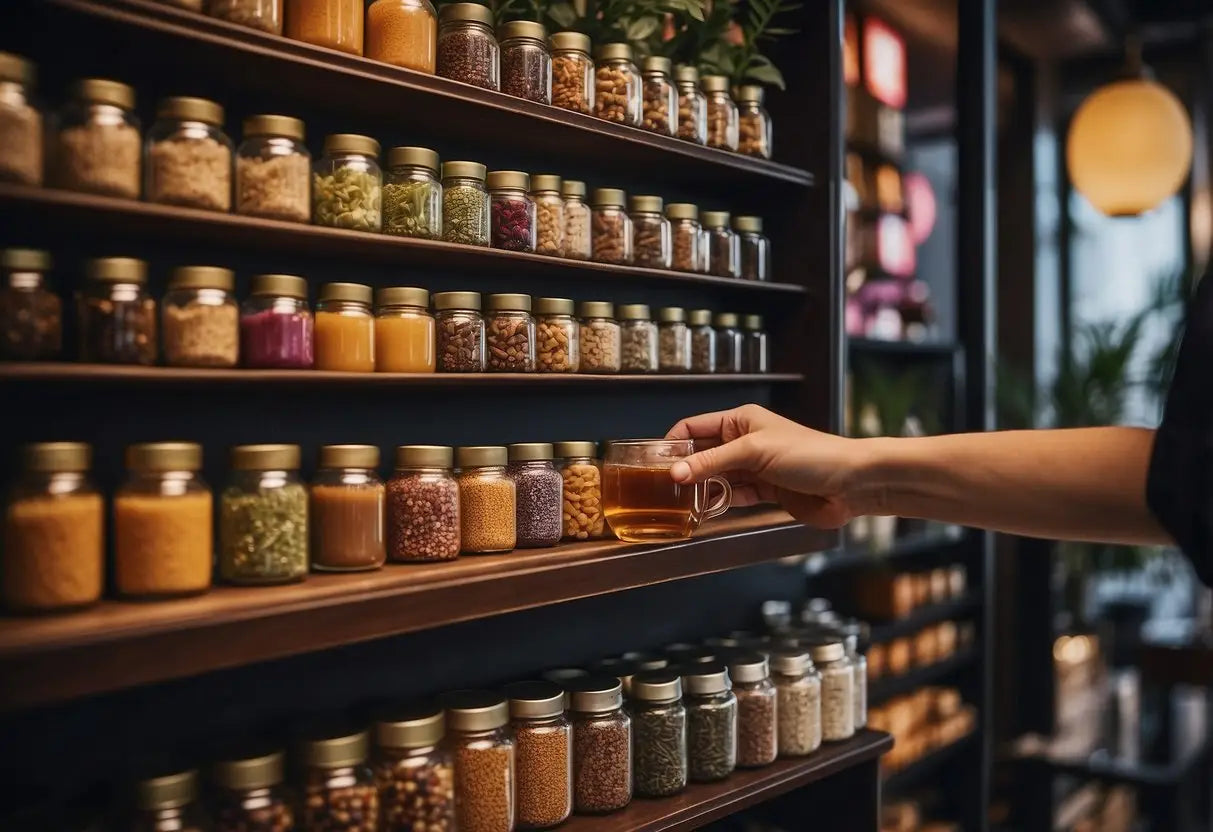
When selecting a quality dessert tea, consider the ingredients. Look for natural flavors and high-quality tea leaves. Avoid artificial additives or low-grade tea dust.
Assess the aroma. A good dessert tea should have a pleasing, inviting scent. This often indicates the quality and freshness.
Inspect the appearance of the tea. Whole leaves or large pieces of fruit and spices usually indicate superior quality.
Taste before you buy, if possible. Many retailers offer samples. Take advantage to ensure the tea meets your preferences.
Check the packaging. High-quality dessert teas are often packed in airtight containers. This helps preserve the flavor and aroma.
Look for reputable brands. Research brands known for their quality and ethics. Trustworthy companies are transparent about their sourcing and production methods.
← Older post Newer post →











